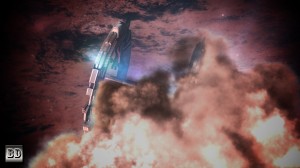Jan 15
4
Vanguard Update…
For the last two weeks I have had my head in the clouds, literally. For the Trailer for Vanguard I needed to create volumetric clouds that could hold up as Photoreal in HD. Doing clouds in 3D means fluid sims- and those are render intensive, to say the least. For Fluid sims that range in the 100+ million particle range, renders can easily hit up 4-6, even 24 hours a frame!
I’ve sampled every major fluid sim program out there, barring Maya’s new NAID simulator. For this project I was investigating three major engines- Real Flow, Krakatoa, and Turbulence FD.
Real Flow is the gold standard Fluid Simulator. It was developed for the movie The Perfect Storm and has become the main player in major Hollywood Fluid Simulation. Real Flow front-loads the work onto your CPU, heavy particle sims are generated and then shipped off to final render.
Krakatoa is a newer simulator but has found a place in many major VFX houses. It’s been used on The Avengers, Avatar and Superman Returns. It’s faster than any engine I’ve ever used, it’s entirely CPU-based so no off-loading renders to a GPU. This is a knock against it.
The third contender was Turbulence FD- it’s the newest player in the Fluid Sim market of these three, and a very exciting one. It produces more particles per second than any of the three and can jump into the 40-50 million pixel range in seconds. This speed comes from utilizing GPU-based rendering. This is a new render philosophy which offloads processing render data through the computers GPU, or Video Card as most people call it.
Newer-generation video cards are data processing monsters. Several massive data mining facilities use a phalanx of GPU-powered farms to glean marketable data from daily Internet traffic- a feat impossible for CPU-based search engines. The lions share of this is performed by NVIDIA GPU technology. I use 2 NVIDIA GPUS in my system- and sticking with NVIDIA tech is the reason I have switched my at-home workstation from Mac to PC.
Real Flow, being highly PC-based, and possessing a complex learning curve, fell by the wayside. Clouds require a minimum of 50 million particles per frame to achieve photo-realism and with Real Flow putting all the rendering on the Central Processing Unit-it was never ideal for my standalone workstation. You need a render farm to run Real Flow the right way.
Krakatoa is also CPU based, though it’s code is far more contemporary than Real Flow. It’s a hot-rod of a program, making the CPU run at optimum speed- but like any hot-rod it comes at a price- rock-solid reliability. You can get a great render out- and very fast, but it is crash-prone. Still it’s render capabilities are astounding! I’ve included a render from Krakatoa and it’s got the visible density of sand. That’s over 200 million particles per frame- far and above my target goal of 50-75 million particles per frame.
I’m going to keep experimenting with Krakatoa- it’s definitely worth learning if you want to do serious 3D work.
My original test-renders were done with Turbulence and I was impressed with my early results. However, the render times were astronomical- multiple hours for a single frame.
I had to nail down a formula for getting that down to 20 minutes a frame, max. After giving Real Flow and Krakatoa their paces I went back to the lab and reformulated my lighting for Turbulence FD. Because it’s GPU-based, it handles rendering multiple-luminance sources much fast than Krakatoa- and you see the final results here.
This project is very exciting! Keep up with us as we will have much more in the New Year!

 Get Updates!
Want to hear what's new at Blinking Dog? All the latest news is available on our website and through email.
Get Updates!
Want to hear what's new at Blinking Dog? All the latest news is available on our website and through email.
